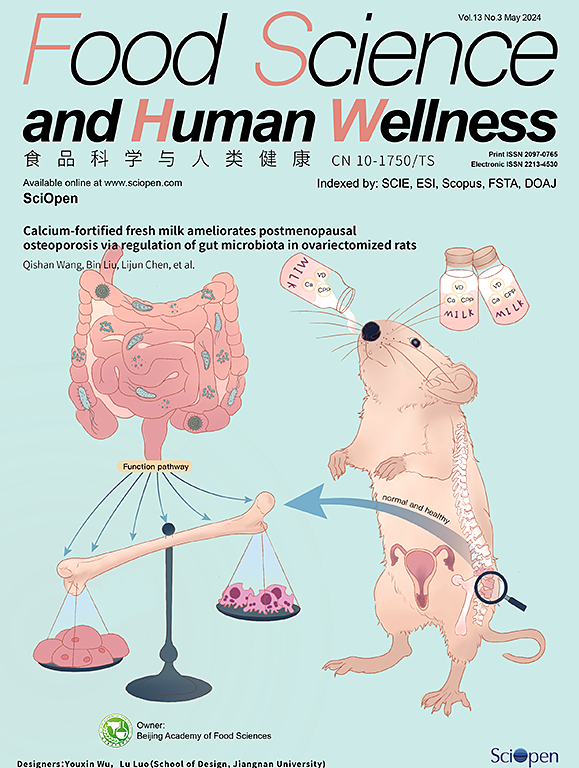富含多糖的旱莲草提取物可改善游离脂肪酸诱导的 HepG2 细胞和高脂/糖饮食小鼠的非酒精性脂肪肝症状
IF 7.4
1区 农林科学
Q1 FOOD SCIENCE & TECHNOLOGY
引用次数: 0
摘要
蕨麻(Potentilla anserina L., PA)属于蔷薇科,是中国青藏高原地区常见的食用植物。本研究阐明了PA粗多糖(PAP)对油酸(OA)和高脂高糖诱导小鼠HepG2细胞脂肪堆积的影响机制。结果显示,PAP可抑制肥胖小鼠脂质积累,改善oa诱导的HepG2细胞的损伤程度。具体而言,与对照组相比,PAP治疗可降低肥胖小鼠细胞和血清中TG和TC水平,降低肝脏中天冬氨酸转氨酶和丙氨酰胺转氨酶含量。经PAP治疗后,SREBP-1c、C/EBPα、PPARγ、FAS等脂肪生成基因的表达均受到抑制。此外,PAP增加了参与脂肪酸氧化的CPT-1和PPARα的mRNA水平。本研究结果表明,PAP可以减轻肥胖引起的肝脏损伤,PAP治疗可能为治疗高脂血症提供一种饮食治疗选择。本文章由计算机程序翻译,如有差异,请以英文原文为准。
Polysaccharide-rich extract of Potentilla anserina ameliorates nonalcoholic fatty liver disease in free fatty acid-induced HepG2 cells and high-fat/sugar diet-fed mice
Potentilla anserina L. (PA) belongs to the Rosaceae family, is a common edible plant in the Qinghai-Tibet Plateau areas of China. This study elucidates the mechanism upon which crude polysaccharide of PA (PAP) on fat accumulation in HepG2 cells stimulated by oleic acid (OA) and high fat high sugar induced mice. The result revealed that PAP inhibited lipid accumulation in obese mice and ameliorated the degree of damage in OA-induced HepG2 cells. Specifically, compared to the control group, the TG and TC levels were decreased in cells and mice serum, the aspartate transaminase and alamine aminotransferase contents were declined in liver of obese mice by PAP treatment. The expressions of adipogenic genes of SREBP-1c, C/EBPα, PPARγ, and FAS were inhibited after PAP treatment. Moreover, PAP increased the mRNA levels of CPT-1 and PPARα, which were involved in fatty acid oxidation. The present results indicated the PAP could alleviate the damage of liver associated with obesity and PAP treatment might provide a dietary therapeutic option for the treatment of hyperlipidemia.
求助全文
通过发布文献求助,成功后即可免费获取论文全文。
去求助
来源期刊

Food Science and Human Wellness
Agricultural and Biological Sciences-Food Science
CiteScore
8.30
自引率
5.70%
发文量
80
审稿时长
28 days
期刊介绍:
Food Science and Human Wellness is an international peer-reviewed journal that provides a forum for the dissemination of the latest scientific results in food science, nutriology, immunology and cross-field research. Articles must present information that is novel, has high impact and interest, and is of high scientific quality. By their effort, it has been developed to promote the public awareness on diet, advocate healthy diet, reduce the harm caused by unreasonable dietary habit, and directs healthy food development for food industrial producers.
 求助内容:
求助内容: 应助结果提醒方式:
应助结果提醒方式:


